The Writers Workbench
CES 2017: There’s No Place Like Ohm
Robert J. Elisberg
Even though Christmas and New Year’s Day are over, the first week of January is nonetheless what I consider The Most Wonderful Time of the Year. That’s because it means it’s time for the Consumer Electronics Show in Las Vegas. Yes, the show is a bit of a convoluted circus, overcrowded and exhausting, but for me that comes with the territory when you’re dealing with Disneyland for adults.
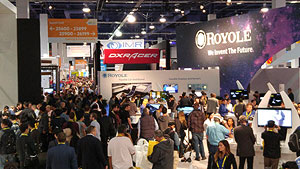 I give my annual warning that this article will be long. Not cute-long, or “longer than usual,” but long. Imagine thinking, “What’s in heaven’s name is he doing???!” as you read an article that seems endless. That’s the kind of long I’m talking about. If something lengthy like this isn’t for you, I understand. Take off now, and we hope to see you next time. But no reading the thing and complaining about how long it is…because you’ve been warned. Then again, maybe you like to know about gadgets and technology that’s upcoming, and what wandering the halls of CES is like. If so, read on, MacDuff.
I give my annual warning that this article will be long. Not cute-long, or “longer than usual,” but long. Imagine thinking, “What’s in heaven’s name is he doing???!” as you read an article that seems endless. That’s the kind of long I’m talking about. If something lengthy like this isn’t for you, I understand. Take off now, and we hope to see you next time. But no reading the thing and complaining about how long it is…because you’ve been warned. Then again, maybe you like to know about gadgets and technology that’s upcoming, and what wandering the halls of CES is like. If so, read on, MacDuff.
But first, some opening observations.
I’ve noticed during the years that CES tends to have a theme each show that predominates the events. It’s sometimes difficult to decipher immediately, but with enough walking around it eventually presents itself. What I’ve also noticed is that every few years, technology has advanced so much that it really has no place to go and needs a year or so to recharge itself (no pun intended). This seemed one of those years. Technology has gotten so sophisticated that I didn’t spot any great advance that was pushing the industry—instead, what I heard often (which became the theme to me) is how “We redesigned our line this year which consumers will really love.” Personally, I don’t care all that much with design when it comes to tech—I like good design well enough, but it’s not my driving force when determining the strengths of technology. Some people do love it, but that’s usually (I think) when the technology is there and does what the consumer wants. It’s then that people look to its design. And I sensed that this is what was happening at CES this year.
That isn’t to say there weren’t technologies that predominated. There were. Several. It’s just that they didn’t signal a new direction.
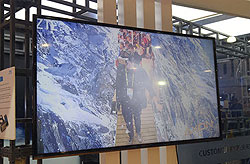 For instance, analysts have been talking about how VR (Virtual Reality) is going to be The Next Big Thing. And it might be. And there was a many more companies pushing it this year. But it felt like people still haven’t quite figured out yet what to do with it. It’s still largely games, which is fine—and the technology for that is impressive—but the expectation is it can do so much more, and I haven’t seen that yet. (This here is from the ZTE booth, where visitors could walk on a wooden bridge with VR goggles, and the monitor showed what they saw.)
For instance, analysts have been talking about how VR (Virtual Reality) is going to be The Next Big Thing. And it might be. And there was a many more companies pushing it this year. But it felt like people still haven’t quite figured out yet what to do with it. It’s still largely games, which is fine—and the technology for that is impressive—but the expectation is it can do so much more, and I haven’t seen that yet. (This here is from the ZTE booth, where visitors could walk on a wooden bridge with VR goggles, and the monitor showed what they saw.)
By the way, AR—Augmented Reality—was much more prominent at this show than in the past. The difference is basically that VR is like watching some video in goggles that takes you into its own self-enclosed world. AR tends to use lighter glasses and you see images displayed in your actual environment, like a elephant in your very own living room. It too is still largely game-oriented, though I can see medical applications for it. Not with an elephant in the surgical theater, but…okay, you get the point.
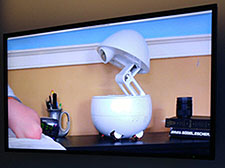 There were also even more personal drones this year, something I suspect will have a big place in the landscape, in part for game enthusiasts, but also in business applications—for better or worse. And to my surprise there was a big growth in, of all things, robots. They haven’t gotten to the point yet of doing anything that seems of critical benefit for people, and seem more novelty conversation pieces. A surprising number are for babies, which largely read stories. What I found a hoot though was that one was named Jibo and another company’s Yobi. I'm detecting a pattern...If you stretch the category to include products like Amazon’s Alexa-powered Echo, LG’s ThinQ Hub, Panasonic’s Robot-Mini, and Lenovo’s Smart Assistant—voice-command “personal assistants” that are stationery rather than are mobile and wander around—then those and many others were sprouting up all over. Some, though, like this Panasonic Desktop Companion did their best to be R2-D2-like.
There were also even more personal drones this year, something I suspect will have a big place in the landscape, in part for game enthusiasts, but also in business applications—for better or worse. And to my surprise there was a big growth in, of all things, robots. They haven’t gotten to the point yet of doing anything that seems of critical benefit for people, and seem more novelty conversation pieces. A surprising number are for babies, which largely read stories. What I found a hoot though was that one was named Jibo and another company’s Yobi. I'm detecting a pattern...If you stretch the category to include products like Amazon’s Alexa-powered Echo, LG’s ThinQ Hub, Panasonic’s Robot-Mini, and Lenovo’s Smart Assistant—voice-command “personal assistants” that are stationery rather than are mobile and wander around—then those and many others were sprouting up all over. Some, though, like this Panasonic Desktop Companion did their best to be R2-D2-like.
(Part of the reason for the existence of the latter “smart assistant” devices is that many act as hubs to “connected homes,” and let you control your lights, washer, TV, refrigerator and more. That’s a field that’s becoming second nature in technology.)
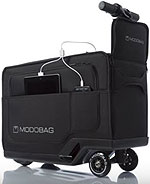 Oddly, I also saw a lot of electric scooters this year, the bulk of which seemed more electric bikes. Many were foldable and let you carry them once you reached your destination—though “carry” is an operative term, and they seemed heavier for that than ideal. Though the pure scooters were lighter. One interesting and offbeat device stood out as unique, from the startup company Modobag. On the surface it’s a piece of luggage, like large carry-on size, with wheels. A closer look though shows that it has handles, a foldable footrest, and you can sit on it and ride! It has two modes—5 MPH and 8 MPH, with an 11 mile range, and weighs 20 pounds. It certainly is fascinating. There were two issues for me, though: as luggage, I found it ho-hum, well-built but not many pockets. And also…it’s $1,495. I greatly admire the technology and creativity. I question the need, especially at that price.
Oddly, I also saw a lot of electric scooters this year, the bulk of which seemed more electric bikes. Many were foldable and let you carry them once you reached your destination—though “carry” is an operative term, and they seemed heavier for that than ideal. Though the pure scooters were lighter. One interesting and offbeat device stood out as unique, from the startup company Modobag. On the surface it’s a piece of luggage, like large carry-on size, with wheels. A closer look though shows that it has handles, a foldable footrest, and you can sit on it and ride! It has two modes—5 MPH and 8 MPH, with an 11 mile range, and weighs 20 pounds. It certainly is fascinating. There were two issues for me, though: as luggage, I found it ho-hum, well-built but not many pockets. And also…it’s $1,495. I greatly admire the technology and creativity. I question the need, especially at that price.
A final word. Every year people ask what “cool things” I’ve seen at CES. Generally they’re thinking of devices with a lot of high-tech whiz bang, but for me what’s cool is something you use every day that makes your life easier. So, a Cool Thing Award-winner is often something very basic, but extremely clever and helpful. I’ll note them throughout.
Okay, that’s a general overview. (Yes, that was only the “overview.”) Now we dive in and take to the halls and get a detailed look at the products themselves. As I said, run for the hills if you don’t like “long.” But for those who want to know what technology is out there, then buckle up.
And home is always a good place to start a journey. The “connected home” (also called “smart home”) has been growing in prominence for several years. But rather than look at this specific sophisticated technology, I thought it would be best to go in the opposite direction and discuss something I noticed throughout the show, and that’s how profoundly “normal” home products that you’d never think would be turned into high tech now are.
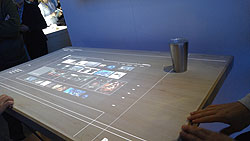 For instance, a bathroom mirror. Yes, there are now “smart mirrors.” I saw two, in fact, from Griffn Technologies and Hi Mirror. These display weather information, your daily calendar, and text messages. The Hi Mirror will even stream Internet radio, and analyze your skin (the rep loved telling me endlessly how it will analyze your skin). Griffin, a very good company for largely Apple-related products, is expanding into home devices as well with a Smart Toaster (which among other things will tell you how much time is left before your toast is done) and its Connected Coffee Maker, all of which work in concert with iOS apps. Or there’s are high-tech toothbrushes. The Oral-B Genius connects to an app to tell you if you’re brushing at the proper angle or long enough, or can adjust to massage mode. MySize is, in essence a ruler—but it’s in the form of an app that lets you measure anything with your Smartphone. How about a basic table? Yes, Panasonic is working on a Smart Table that can change into a full monitor display with extensive touch capability.
For instance, a bathroom mirror. Yes, there are now “smart mirrors.” I saw two, in fact, from Griffn Technologies and Hi Mirror. These display weather information, your daily calendar, and text messages. The Hi Mirror will even stream Internet radio, and analyze your skin (the rep loved telling me endlessly how it will analyze your skin). Griffin, a very good company for largely Apple-related products, is expanding into home devices as well with a Smart Toaster (which among other things will tell you how much time is left before your toast is done) and its Connected Coffee Maker, all of which work in concert with iOS apps. Or there’s are high-tech toothbrushes. The Oral-B Genius connects to an app to tell you if you’re brushing at the proper angle or long enough, or can adjust to massage mode. MySize is, in essence a ruler—but it’s in the form of an app that lets you measure anything with your Smartphone. How about a basic table? Yes, Panasonic is working on a Smart Table that can change into a full monitor display with extensive touch capability.
There is now a very big and growing market for Smart light bulbs that you either screw in directly (everything being built in), or screw into an adapter, like ones from Qube, Incipio, Ilumi, and the Sengled Element bulb (which they call carbon neutral, since the company will plant a tree for every bulb sold), along with many others. With an app, you can adjust the bulb’s brightness, change the color, set the time it goes on and off, and more.
And when it comes to basic and normal at the home, even Play-Doh. You read that right…Play-Doh. Now admit it, would you think of Play-Doh at a high-tech show?? Not only that, but it’s a very clever, creative application of technology, so much so that I give it one of my Cool Thing Awards. And if you’re a parent with little kids, this is deserving. Their toy is called Play-Doh Touch. Basically you form the Play-Doh into whatever object you want, like an animal. Then, placing your design on a platform (the Play-Doh Studio), you use an app to scan it into your tablet or Smartphone. This creates an image which then is inserted directly into a little video, and you can manipulate it through the video by touching the screen of your tablet or Smartphone and sending the creature that you ("you" in this case, of course, being the child) created on its own adventure.
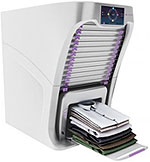 One of the odder, though very innovative “normal home” devices is the Foldimate. This a product that…well, folds your clothes. It’s still a work in progress, not ready for sale, but worked well. That said, I think it’s of most interest only to homes with a LOT of children, or to businesses like laundromats or hotels. That’s because it’s fairly large and expensive, anticipated to be $750-800.)
One of the odder, though very innovative “normal home” devices is the Foldimate. This a product that…well, folds your clothes. It’s still a work in progress, not ready for sale, but worked well. That said, I think it’s of most interest only to homes with a LOT of children, or to businesses like laundromats or hotels. That’s because it’s fairly large and expensive, anticipated to be $750-800.)
How down-to-earth basic are we talking for high tech? If you’re a gardener and spend a long time creating your own…er, compost, there is now a high-tech way to do that. Rather than take 18 months or so to properly get it in fertilizer-shape, the Whirlpool Zera can turn leftovers to well-ground compost in two days—and without any accompanying…er, aromas. It doesn’t come cheap, though, at $1,200.
But it’s the “connected home,” as I said, that’s really the direction technology is headed. Sometimes, products are labeled “smart homes” because it’s a marketing tool, but the general concept remains. These are devices that not only communicate with one another, but which you can run from afar on apps. I question whether the smart/connected technology is especially necessary in most cases, but in part that might be because the field is new. At some point it likely will be second nature, and fully-useful features will be built-in to new homes and appliances. But completely valid or not, this is oddly the area of tech, at least on the appliance end, that most intrigues me. So much of technology today is very mature—TVs, cameras, mobile phones and so on—but companies are just learning to innovate with appliances.
LG, Samsung and Panasonic were the most notable at CES, though companies like Bosch, Miele and Haier are prominent in Europe. LG, for instance, has its TwinWash, which lets you split your wash to just a small load if that’s all you need to save energy. (I still remain more impressed with the DuoDry from the European company Haier I saw last year in the IFA show in Berlin. It’s an all-in-one, compact, integrated unit with a small washer on top, while underneath the larger barrel doubles as a dryer. There are no plans right now to sell it in the U.S., however Haier recently bought GE in June, so it’s possible those plans could change.)
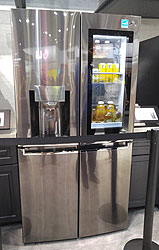 I also like the clever InstaView Door-in-Door refrigerator from LG that has a transparent door so you can see inside. This keeps you from opening the door and staring inside, wasting energy. Tap on the window twice to light up the inside.
I also like the clever InstaView Door-in-Door refrigerator from LG that has a transparent door so you can see inside. This keeps you from opening the door and staring inside, wasting energy. Tap on the window twice to light up the inside.
Some new fridges have built-in cameras and WiFi that let you check inside while you’re at the grocery store to determine what you might be in short supply of.
This is one place where you’ll use one of those voice-activation device, like LG’s Robot-Mini Which controls all your connected LG devices—the refrigerator, washing machine, dishwasher, stove and whatever other appliances fit in.
Home appliances are even entering the commercial world. The Orangerie lets you get fresh-squeezed orange juice in a self-contained kiosk. (You load it with oranges, and it squeezes them on demand.) Similarly, any store can add a new revenue stream with a Frobot, basically an automated frozen yogurt kiosk that serves three different flavors. It was very tasty and smooth, though a touch sweet for my taste. The flavors are limited, but you don’t need a full store front or any of its attendant costs.
Once upon a time there was another technology for the home that overwhelmed CES—in fact, it even had its own show, Comdex, that came a few months earlier. But no more. I’m speaking of the venerable PC, as well as laptops. Laptops are still prevalent at the show, but a far-small aspect of it. And now their presence is mostly in the growing field of 2-in-1 or convertible devices, which are basically laptops that can have their touch-screen twisted or removed completely to become tablets.
I won't get into these 2-in-1's since without reviewing them it’s hard to tell the differences, but I saw several from HP, Lenovo and Dell. They’re very “mature” and versatile, with some being impressively light and thin. What I will note is a few offbeat related things that stood out.
 Most notable is the Ockel Sirius which will be released in May. It’s a full-featured PC running Windows 10 with up to a solid 8 GB of RAM and 128 GB of Flash storage for $799—and it fits in your pocket! The PC is about the size of a mobile phone, with a 6” screen. You can either use it like a portable CPU case and plug in a keyboard and monitor from any office, or connect only a portable keyboard and use the Ockel’s screen as your monitor. It can also be used standalone, with the screen doubling as a touch-screen keyboard, albeit a cramped one for serious typing. It’s full of ports—USB3, USB-C, HDMI, LAN, MicroSD, and a display port. And it can be used for games and as a remote control. The downside is that there are some excellent, full laptop PCs that are very light and small, and easily portable—no, they won’t fit in your pocket. But they have a full-size keyboard and full size screen. No need to borrow someone else’s monitor and keyboard. For about the same price. And some very acceptable ones for quite a bit less. I think there are valid uses for the Ockel Sirius because of its incredible portability, though it needs to fit specific and more-limited usage for a person—or perhaps in the field for a business—even though it itself is respectably and impressively powerful.
Most notable is the Ockel Sirius which will be released in May. It’s a full-featured PC running Windows 10 with up to a solid 8 GB of RAM and 128 GB of Flash storage for $799—and it fits in your pocket! The PC is about the size of a mobile phone, with a 6” screen. You can either use it like a portable CPU case and plug in a keyboard and monitor from any office, or connect only a portable keyboard and use the Ockel’s screen as your monitor. It can also be used standalone, with the screen doubling as a touch-screen keyboard, albeit a cramped one for serious typing. It’s full of ports—USB3, USB-C, HDMI, LAN, MicroSD, and a display port. And it can be used for games and as a remote control. The downside is that there are some excellent, full laptop PCs that are very light and small, and easily portable—no, they won’t fit in your pocket. But they have a full-size keyboard and full size screen. No need to borrow someone else’s monitor and keyboard. For about the same price. And some very acceptable ones for quite a bit less. I think there are valid uses for the Ockel Sirius because of its incredible portability, though it needs to fit specific and more-limited usage for a person—or perhaps in the field for a business—even though it itself is respectably and impressively powerful.
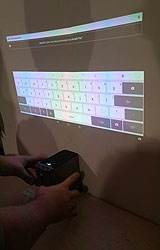 There a few other uncommon computers (for lack of a better word, but that’s basically what they are)—like the Typelet, as well as the Viotek Lazertouch. Both of these were concept products in their early stages, not ready for the market yet, but basically run full operating systems that display on the wall or a tabletop, whose images are touch-based. (In some ways they are cousins to the aforementioned Panasonic Smart Table, though that was more full-featured with other capabilities.) The Typelet runs an Android operating system, though it wasn’t clear about the Lazertouch. The biggest problem for both is not that they weren’t yet ready, or the expensive cost or uncertainty of the application uses (though the technology is intriguing and I think valid under certain circumstances, basically in the business arena). No, the biggest hurdle is that there is a third competitor—Sony, with their Xperia, which is not only in much better, current shape and almost ready for release this year, but…well, it’s Sony.
There a few other uncommon computers (for lack of a better word, but that’s basically what they are)—like the Typelet, as well as the Viotek Lazertouch. Both of these were concept products in their early stages, not ready for the market yet, but basically run full operating systems that display on the wall or a tabletop, whose images are touch-based. (In some ways they are cousins to the aforementioned Panasonic Smart Table, though that was more full-featured with other capabilities.) The Typelet runs an Android operating system, though it wasn’t clear about the Lazertouch. The biggest problem for both is not that they weren’t yet ready, or the expensive cost or uncertainty of the application uses (though the technology is intriguing and I think valid under certain circumstances, basically in the business arena). No, the biggest hurdle is that there is a third competitor—Sony, with their Xperia, which is not only in much better, current shape and almost ready for release this year, but…well, it’s Sony.
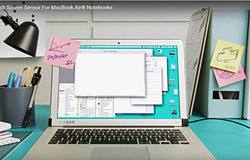 I also came across a few interesting accessories for laptop/PCs. The first in fact is another of my Cool Thing Award winner, the AirBar. This is a device that works for a laptop or desktop computer, but is best-suited for the former. What it does is turn any monitor into a touchscreen. Yes, really. It’s about the size of a one-inch thick ruler—you place it under your laptop’s monitor where it attaches by a magnet, and then plug it into your computer’s USB port. And that’s it. You now have a touchscreen. The company’s website is poorly written (which suggests Mac only), but I confirmed with the company that there are currently several models for PCs, retailing at $69 with more PC models (at different lengths) to come. And MacAir versions will be coming in March for $99.
I also came across a few interesting accessories for laptop/PCs. The first in fact is another of my Cool Thing Award winner, the AirBar. This is a device that works for a laptop or desktop computer, but is best-suited for the former. What it does is turn any monitor into a touchscreen. Yes, really. It’s about the size of a one-inch thick ruler—you place it under your laptop’s monitor where it attaches by a magnet, and then plug it into your computer’s USB port. And that’s it. You now have a touchscreen. The company’s website is poorly written (which suggests Mac only), but I confirmed with the company that there are currently several models for PCs, retailing at $69 with more PC models (at different lengths) to come. And MacAir versions will be coming in March for $99.
Kensington also has a few very helpful security accessories for laptops. The laptops today that are designed to be as thin as possible no longer have space for a locking port that secures your computer when you wander off. The Laptop Locking Station, however, cleverly brings back that capability. It retails for $120. And their VeriMark device plugs into a USB port and provides fingerprint capability for accessing your Windows 10 computer, allowing you to stop using hackable passwords. It retails at $50.
But what’s a home without a TV? Or cheese dip, for that matter? But since they haven’t figured out yet how to do the latter, we’ll stick with television. Actually, there are a few fields at CES I rarely write much about, and TV is one of them. Cameras and mobile phone cases are the others. With cases, there are just too many, a horrifying tsunami roaring at you as you wander the halls. As for TV and cameras, the level of technology is so high, even for lower-end models, that I find it problematic unless you’re focusing on one specific model. With TVs, I tell people—ask your friends what they have and what they like and don’t about it, and then go to the store to buy it. Or get what’s on sale…
There’s another problem with writing about TVs at CES. Every company has their own techno-jargon which is meaningless, explaining why their technology is the greatest ever. Hybrid Log Gamma, Super Mapping Bit, Quantom Dot, Nano Cell Technology. Whatever.
Actually, there is one technology you should look for—HDR. That’s High Dynamic Range. The most important thing in getting a realistic image is contrast ratio, and HDR expands that level on both the bright and dark ends, which makes for a greater ratio and therefore a more realistic picture. So, a medium-cost TV with HDR should look better than a high-end TV without HDR. (The more expensive model, of course, will have more bells-and-whistles.) That said, it’s not likely that any high-end TV won’t have HDR. But if there are two comparably-priced sets and only one has HDR, that’s where to look first.
Another good feature is an OLED screen. Once upon a time, they were only available in small profiles, like for mobile phones. But technology has advanced to the point where they can be made larger and reasonably cost-efficient.
What I found fascinating though not surprising is what wasn’t there. And that’s a near-total absence of the once-highly promoted “curved screens” of just a couple years ago. At the time when they were introduced, I wrote that I thought it was a pointless technology, and the public seems to have agreed. The only company I saw making any real effort to still push curved screens (which wasn’t much) was Samsung.
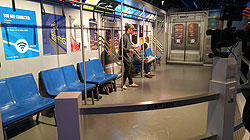 Among those displaying impressive TVs at the show were LG, Sony, Samsung, and several Chinese companies trying to break into the U.S. market, Hisense, TCL and Haier. Others are made, of course, and from big companies, I just either didn’t come across their booths or their displays. For instance, as massive as Panasonic’s booth was, I didn’t see any TVs there. More on Panasonic a bit later, but one thing the company did do again—and it seems to be becoming a bizarre annual feature—is they had a big, intricate display that exists for no apparent reason. Panasonic has a great range of kitchen appliances, health-and-beauty products, connected-home devices, car accessories and much more, and their area is always interestingly presented and designed. Except for their one, inexplicable stand-alone exhibit. And this year, why they had a subway car with a couple of passengers reading the paper and rapping is utterly beyond me.
Among those displaying impressive TVs at the show were LG, Sony, Samsung, and several Chinese companies trying to break into the U.S. market, Hisense, TCL and Haier. Others are made, of course, and from big companies, I just either didn’t come across their booths or their displays. For instance, as massive as Panasonic’s booth was, I didn’t see any TVs there. More on Panasonic a bit later, but one thing the company did do again—and it seems to be becoming a bizarre annual feature—is they had a big, intricate display that exists for no apparent reason. Panasonic has a great range of kitchen appliances, health-and-beauty products, connected-home devices, car accessories and much more, and their area is always interestingly presented and designed. Except for their one, inexplicable stand-alone exhibit. And this year, why they had a subway car with a couple of passengers reading the paper and rapping is utterly beyond me.
There is, however, one TV item I do tend to write about, and that’s the Ultra-D technology from Stream TV Networks. And yes, I know it remains a long-time coming, as a “soon to be released” technology, but they’re now in limited production and there are some things at hand that make me suspect this is the year they go full-force. Ultra-D is a technology that allows for 3D-TV but without needing glasses. I know that people think that 3D-TV is dead, but that’s because the technology with glasses was terrible, and not the way people watch TV. When it was introduced I wrote a long piece explaining why it was doomed to failure—as it was. But 3D-TV without glasses is an entirely different technology, which shouldn’t be conflated with its similarly-named cousin…and it resolves all the problems of the other. For one thing, there’s no issue with near-total lack of content—it can instantly convert in real-time any 2D TV show into 3D. You can also adjust the level of 3D, even down to nothing if you want to watch in regular TV. (3D-TVs with glasses were 3D only.) And of course, most importantly…you don’t need glasses! You can read a book, browse your tablet, talk to others in the room, go to the kitchen and watch TV at the same time all just fine. TV sets with the Ultra-D technology are already selling in China, and the company is having success here with glassless 3D signage for advertising. And upcoming they’re working on Ultra-D glassless-3D for tablets (particularly great for playing games on the road) and even mobile phones. The bottom line, too, is that I’ve seen it in action and just saw the latest improvements, and the technology works quite great. This year, I was with my friend Walter Podrazik, curator of the Museum of Broadcast Communication in Chicago, and co-author of the book, Watching TV: Eight Decades of American Television, (now in its 3rd edition), and even he—who knows more about TV than anyone I know—came away impressed. We’ll see. They’ve been close before, and it’s yet to hit the market here in full production, but from things I was told it’s worth keeping a very close eye on them.
Okay, this has been going on for a while, so I think it’s a good time to give you a break and have a sort of intermission. A chance to stretch your legs perhaps or get a snack for energy. Maybe a bathroom break. Not to worry, we’ll wait. Go ahead…
Fine, you’re back? Wonderful.
Before we left, we were talking about fields I generally don’t write about at CES. And this brings up another one I had mentioned earlier that I also generally don’t write about—cameras. The range of cameras is so extensive and picture quality is of such high quality that it just never strikes me as worth diving into overall. But this year I noticed a big change in that world. It’s the development of 360° cameras, whose presence was significantly greater than even a year ago. One of the very few then was the Kodak PixPro 360°. Some of these today now promote themselves as “3D,” even though they really aren’t, but they give a depth-perception which is that rich and immersive. Some also calls themselves “VR”—but they aren’t either, there’s nothing “virtual” about their reality, though the resultant photos work well in the technology. Basically they take pictures from every angle and then “stitch” them together to give a 360° view, which you can access on a touch screen by dragging the resultant photo full circle.
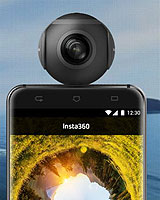 There are both standalone 360° cameras and quite a few that attach to mobile phones (which you run with an app, since phones aren’t designed for this technology so you can’t fully utilize a phone’s camera features.) One company that caught my attention was Insta360. In particular, they had quite a few Smartphone models (along with some standalone). On the phone end, the Nano works with an iPhone. It’s a thin device that neatly slides over the back of the iPhone with the lens on top. Their Air version (despite the Apple-sounding name) is for Android phones, and is a ball that sits on top. It releases next month for $129. (This is less than the $200 Nano, though the Nano can be also used standalone, without being attached to an iPhone.) Both versions will be able to live stream—the Nano can do so in 360° format, though it’s not certain whether the Air version will be able to. To be clear, the company also makes standalone 360° cameras that don’t need to be attached to a mobile phone.
There are both standalone 360° cameras and quite a few that attach to mobile phones (which you run with an app, since phones aren’t designed for this technology so you can’t fully utilize a phone’s camera features.) One company that caught my attention was Insta360. In particular, they had quite a few Smartphone models (along with some standalone). On the phone end, the Nano works with an iPhone. It’s a thin device that neatly slides over the back of the iPhone with the lens on top. Their Air version (despite the Apple-sounding name) is for Android phones, and is a ball that sits on top. It releases next month for $129. (This is less than the $200 Nano, though the Nano can be also used standalone, without being attached to an iPhone.) Both versions will be able to live stream—the Nano can do so in 360° format, though it’s not certain whether the Air version will be able to. To be clear, the company also makes standalone 360° cameras that don’t need to be attached to a mobile phone.
I haven’t ever written much about cars at CES either, even though there is a massive presence. As is getting apparent to consumers already, cars are getting to be motorized computers and connected devices. And it’s growing. One display that impressed me enough to actually take a lot of notes was for Panasonic. Most notably, I was taken by their Navigation Monitor, which is in development and will powered by Android and IBM Watson. It’s much more intricate and intuitive than the display panel that cars have now. The portal starts by setting up a driver profile and logs in your favorite music type, restaurants, places, and more, like how you prefer your seat adjusted (if several people use the car). It uses facial recognition to jump directly to your preferences—another possible feature of this, too, may be that the car will only be able to be start if a face is recognized. (Two of the designers were at the booth.) It’s voice-activated, and you can describe a meal you want, and it will match that to restaurants nearby. Or set up favorite places, and it will remember the routes. (Though likely you’ll remember them, too, since they’re your favorites…) It also will be able to control third-party devices, like garage openers. And if your car has speakers in the headrests (which many likely will soon enough), you’ll be able to set up “audio zones” and play music directly to specific locations in the car.
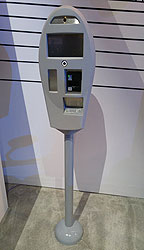 Panasonic had some other car-related products, though for cities and towns, like—really—their Smart Bus Shelters (providing real-time transit info, weather reports, surveillance, and ad displays) and Smart Parking Meters. These latter include video cameras, support apps, allow for ads that bring in revenue for the city, and have ways to help strengthen rule compliance.
Panasonic had some other car-related products, though for cities and towns, like—really—their Smart Bus Shelters (providing real-time transit info, weather reports, surveillance, and ad displays) and Smart Parking Meters. These latter include video cameras, support apps, allow for ads that bring in revenue for the city, and have ways to help strengthen rule compliance.
One other car product caught my attention. On the surface, Meineke CarCare's product Revvy looked great. You plug the device into your care's OBD2 port (that's On Board Diagnostic, all recent cars have one), and when it recognizes that your car has an issue, like when a warning light goes off, it will tell you what the problem is, via the app to your Smartphone, or will connect you to a real person at Meineke. All well and good. The problem is that if you don't want Meineke to know your data, it's hard-coded in, so it can't be shut off. And because there's GPS functionality, that means Meineke will know your whereabouts when driving. It's not inherently a big concern, but it certainly does raise privacy issues.
Needless-to-day, all of these devices mean the requirement for power (and generally portable power) has grown precipitously. And that means, as some regular readers of these columns know, it brings us to one of my inexplicably favorite areas—portable chargers. O huzzah! And yes, happily, there are some intriguing advances.
Two of my favorite charger companies are TYLT and myCharge, and both have a new device that elegantly resolves a long-held challenge: charging a laptop when on the road and away from an AC outlet. In the past, there have been a few devices that could handle this, but they all required the pesky problem of using the proper “tip” to fit in the charging port of your computer, and more importantly have generally been fairly heavy. Both these new devices though have an AC outlet actually built-in, which means you simply can plug in your laptop with its standard power supply brick. (More on this in a moment.) And they’re both impressively light, at least by comparison to what was the previous option. TYLT’s is called the Awall, which holds a huge 26,800 mAh (milliamp)—for point of comparison, a mobile phone uses around 1,500-1,800 mAh for one charge. There are additionally two USB ports. The myCharge unit is their Adventure Extreme. Its capacity is a bit less at 20,600 mAh, though that’s a lot (indeed, both should likely fully charge a laptop or come close), and for its two USB ports, one is the new Type-C standard. They both retail for around $130. By the way, know too that these aren’t just for charging a laptop or mobile phone, but you can plug in almost any small portable device if you’re on the road or camping. A portable TV, for instance, could run for about five hours on one of these highly-portable chargers. I give both my Cool Thing Award.
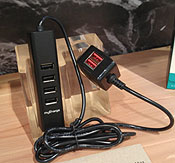 In fact, I also give a Cool Thing Award to another charger from myCharge. It is definitely not whiz bang. Very simple, but such a smart and natural idea. There are a lot of car cord chargers that plug into your car’s cigarette lighter and provide a charging outlet for your mobile devices. And that’s great if you’re sitting in the front seats. But not only do a lot of folks have actual children, who sit in the back, but those kids are often the people with the most portable devices for games or portable whatever. Which brings us to the myCharge CarHub QC. It’s a car charger with two USB ports…but also a long extended cord that will reach into the back seat with four additional USB ports. It will be available in April.
In fact, I also give a Cool Thing Award to another charger from myCharge. It is definitely not whiz bang. Very simple, but such a smart and natural idea. There are a lot of car cord chargers that plug into your car’s cigarette lighter and provide a charging outlet for your mobile devices. And that’s great if you’re sitting in the front seats. But not only do a lot of folks have actual children, who sit in the back, but those kids are often the people with the most portable devices for games or portable whatever. Which brings us to the myCharge CarHub QC. It’s a car charger with two USB ports…but also a long extended cord that will reach into the back seat with four additional USB ports. It will be available in April.
You’ll recall that I mentioned above how you can plug your laptop’s power supply brick into those two portable chargers. That’s fine and easy, though when it comes to portability, power bricks are known to live up to their name. Most are smaller and lighter than years back, but they’re still fairly bulky and heavy. That’s where the FINsix Dart comes in. It was introduced a few years ago, but never hit the market—but after some tinkering it’s here now. This is a small, light device—about the size of a large Bic lighter—that can replace any bigger, heavier power brick. You do need to use adapter tips, but they work quite conveniently here.
And speaking of small, it’s hard to not mention the PlusUs LifeCard. This a portable charger that’s the size of a credit card—literally. It fits in your wallet and even has a built-in plug. It only holds 1,500 mAh, but that’s enough for one full charge of an Android phone, and about an 80% charge of an iPhone. So, for an emergency charge, this is about as portable as they come. It retails for $42.
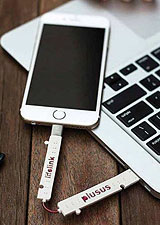 PlusUs also has a similarly-tiny LifeLink. This is for those times you need a USB cable but don’t carry one around. It’s even smaller than a credit card, and so slips easily into your wallet, as well. You twist open the halves, and you now have a flexible cord. It’s similar in theory to a device I’ve reviewed call the Nomad, though that’s less flexible and fits on your keychain. Preference is personal taste.
PlusUs also has a similarly-tiny LifeLink. This is for those times you need a USB cable but don’t carry one around. It’s even smaller than a credit card, and so slips easily into your wallet, as well. You twist open the halves, and you now have a flexible cord. It’s similar in theory to a device I’ve reviewed call the Nomad, though that’s less flexible and fits on your keychain. Preference is personal taste.
And there was an interesting bit of wireless charging technology being developed by Humavox. I’m an admirer of wireless charging, and right now the leading standard goes by the name of Qi (pronounced “chee”). But RF technology also had a foothold, which stands for “Radio Frequency,” using radio waves. What Humavox does is turn any object into a wireless charger. It will embed its chip into the object, and from that point the radio waves will charge a device in its range. For instance, imagine a backpack with an embedded chip. Just toss your mobile phone inside, and it will charge.
Good news. The end is in sight! There's more to go, but the finish line is coming up pretty soon, so you'll be able to return to polite society.
I always find that portable charging and portable audio sort of go hand-in-hand. In fact, almost literally at times, like when the aforementioned TYLT brings out its Block Party, a 20,000mAh charger that doubles as a Bluetooth speaker and its halves can separate to create two unique devices.
One of my favorite new products of the show comes from one of my favorite companies, XMI. I came across them about five years ago when they were hidden away in a tiny booth big enough for maybe three people in the Singapore Zone and they’ve since expanded and matured impressively from their initial “ping pong ball-sized” powerful speakers that twisted open for more bass. Upcoming they have a product that’s so clever it’s hard to figure why no one else came up with it before, the Evolve 2, which is another Cool Thing Award winner. These are very good headphones, but when you flip a switch and twist the earpads out, it becomes a speaker! Just exceedingly clever, and it adds so much functionality. (The sound of the earphones was excellent and quite nice as speakers, the difference between the two is a reality of the size of the driver that can be installed in earphones for an external speaker.)
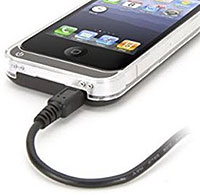 And the aforementioned Griffin Technologies has a helpful idea for iPhone 7 users who miss having an audio jack (because wired sound is higher resolution than wireless Bluetooth which degrades sound when it compresses the algorithms). It’s their Reserve Battery Case for the iPhone 7 that not only includes a 3,000 mAh backup battery, but also a built-in jack to plug in headphones. It will be available in the second quarter of the year and retail for $100.
And the aforementioned Griffin Technologies has a helpful idea for iPhone 7 users who miss having an audio jack (because wired sound is higher resolution than wireless Bluetooth which degrades sound when it compresses the algorithms). It’s their Reserve Battery Case for the iPhone 7 that not only includes a 3,000 mAh backup battery, but also a built-in jack to plug in headphones. It will be available in the second quarter of the year and retail for $100.
I also came across two innovative audio devices at the Eureka Park exhibit. That’s the area in a separate convention hall where start-up companies display their offerings.
The first is from a French company Akoustic Arts which has developed an odd speaker, the A Original (not a great name, but the letter “A” is an icon for the direction of a sound beam). It’s a speaker that focuses its sound waves so that they don't spread out to fill a room, but can only be heard in a confined range. For instance, if the speaker is placed above with the sound beaming down, only when someone walks into that zone will they hear it. (My immediate thought was, oh, my god, this is the "Cone of Silence" from Get Smart come to life!) It’s not really for personal use, but odd as is seems there are real-world commercial applications for it, I think. For instance, in museums or hotel lobbies, that sort of thing. The representative also mentioned some personal use possibilities, though, like in cars and smartphones, and also interestingly for the blind.
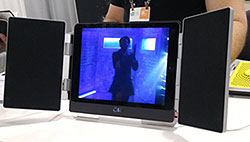 And a college start-up, AMP OIO, has developed a case for an iPad that has fold-out speakers to create “theater” stereo sound. (Other Android tablets could use it, as well, though the size is made the iPad.)
And a college start-up, AMP OIO, has developed a case for an iPad that has fold-out speakers to create “theater” stereo sound. (Other Android tablets could use it, as well, though the size is made the iPad.)
Eureka Park also had a couple of interesting security-based products which overlapped with one another, though went in different directions. The Keezel looks a bit like a bar of soap or a computer mouse and protects your Wi-Fi communication by encryption. What stood out—at least by description, since I haven’t tested it yet—is how easy it is to set up. (You basically make a Bluetooth connection of your device to the Keezel, and connect the Keezel to the Internet.) If you hit the road, you’d have to carry the Keezel with you, but it’s on the small side and fits easily in a coat pocket or purse.
And eBlocker is a “plug-and-play privacy solution.” It blocks different types of nefarious online efforts to gain information about you as you browse the Internet. Things like behavioral typing, credit rating analysis, and others that you can manage through its control panel. One of its most important features is that it does device cloaking, which makes it seem as if you’re using a different device than the one you’re actually one, making it basically impossible to pin down your online identity. And it offers mobile protection, as well.
I don’t tend to write much about health-related products, though the field is massive and impressive. But every once in a while, something breaks through that catches my eye—or in this case, my ear. It’s the ReSound EN202, which is a smart hearing aid. The device is iPhone-enabled, which means that you can use your hearing aid as wireless earphones and stream phone calls, music and other audio to them from an iPhone.
And finally (yes, we’ve come to “finally!”), what would CES be without the oddities? Some are excellent technologies but just don’t have a fighting chance for market, while others—well, they’re “What on earth were they thinking?” sort of things. The technology might lead to other advances, so there can be benefits from even the most-odd failures. Though “can be” is the operative turn, and it leaves a lot of head-scratching.
So much to choose from, as you might imagine, but I’m going to give my winner to Spinali Design, a clothing line that has developed, among other things, a smart connected bikini. Yes, you read that right. It connects with an app that helps the wearer prevent sunburn. It’s a fine and valuable thought. I’m just going to guess it won’t fly very far.
And with that, you may fly from here at last, and I will return with the swallows next year as we now all decompress from CES 2017.
To read more from Robert J. Elisberg about other matters from politics, entertainment, technology, humor, sports, and a few things in between, see Elisberg Industries. He can also be followed at a distance on Twitter or Facebook.
Note: The Writers Guild of America West neither implicitly nor explicitly endorses opinions or attitudes expressed in this article.
Copyright 2017, Robert J. Elisberg. All rights reserved.
